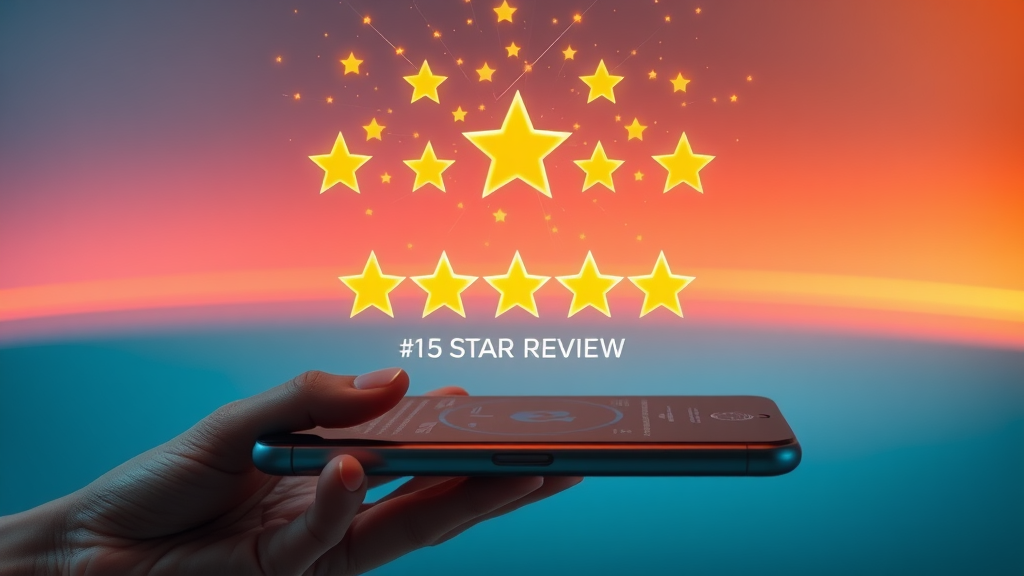Did you know: 89% of consumers are more likely to choose a business that responds to all reviews—positive and negative? In a digital world where a single customer review can make or break your reputation, mastering review response techniques is no longer an option—it's essential. If you want customers to return and advocate for your business, understanding how you address feedback online is the secret weapon for earning their trust and loyalty.
Unlocking Trust: Why Review Response Techniques Make or Break Customer Loyalty
In today’s hyper-connected marketplace, review response techniques aren't just about courtesy—they're about cultivating relationships that foster loyalty and repeat business. When a business thoughtfully replies to every customer review —be it positive praise or constructive criticism—it signals that the brand genuinely values its customers' voices. For example, businesses that answer their negative reviews with empathy and a willingness to resolve issues show potential customers a commitment to excellent customer service.
This approach builds deeper trust. Imagine reading a company’s Google profile and noticing that every review receives a kind, relevant, and timely reply. As a customer, you naturally feel more confident purchasing from that business because you expect to be treated as a priority. In essence, review response techniques help businesses stand apart in a crowded field, turning casual buyers into lifelong fans through proactive engagement and authentic connection.

- Did you know that 89% of consumers are more likely to choose a business that responds to all reviews—positive and negative? In a marketplace ruled by online opinions, mastering review response techniques is the secret to outshining competitors and building a loyal customer base.
What You’ll Gain From These Review Response Techniques
- Discover review response techniques for handling all types of customer review feedback
- Learn proven ways to craft responses for both negative reviews and positive reviews
- Explore response examples and templates for your team
- Foster trust, customer service excellence, and positive online reputation
By the end of this guide, you'll have a toolkit of actionable review response techniques—from turning a negative review into a customer loyalty opportunity, to using positive review response templates. You'll also learn how to create a culture of customer service excellence and how to leverage different platforms to multiply your business's online review advantage. These strategies are key for any leader who aims to up their game in the digital customer experience space.
The Fundamentals of Review Response Techniques: Setting the Tone for Customer Review Success
At the heart of effective review response techniques are three simple truths: respond quickly, respond thoughtfully, and always put the customer’s experience first. Immediate responses to online reviews —whether glowing or critical—reassure both current and future customers that your business is attentive and values feedback. Timing is everything; customers notice when their opinions receive prompt acknowledgment, and speed fosters positive sentiment.
Equally vital is review response etiquette . This means always addressing customers by name whenever possible, expressing genuine gratitude for feedback, and avoiding generic, copy-paste replies. This personalized touch can transform a simple customer review exchange into a memorable brand interaction, supporting long-term reputation growth.
Consistently responding to reviews, no matter the tone, systematically builds your brand’s reputation. Every single customer interaction online is a public show of your company’s culture and commitment to service. By nurturing both your supporters and your critics, you turn daily interactions into tangible business growth.

- Why immediate responses matter for online reviews
- The role of review response etiquette in customer service
- Building brand reputation and loyalty with every customer review
“Your brand isn’t what you say it is. It’s what your customers say it is online.”
The Blueprint for Responding to Positive Reviews: Turning Praise Into Advocacy
Every positive review offers a moment to strengthen a bond with a happy customer and transform them into lifelong advocates. Effective review response techniques here focus on sincerity, personalization, and inviting further engagement. A typical positive review response thanks the customer, speaks directly to their specific praise, and encourages them to connect again—where possible, mention something unique about their experience to signal genuine attention.
By reaching out in response to positive reviews , you create a loop of goodwill and demonstrate that you’re attentive beyond transactional moments. Over time, these customers often become your loudest cheerleaders, sharing their great experience in their networks—both online and off. This is the natural outcome of responding to reviews thoughtfully and making each customer feel like a valued part of your community.
Crafting the Perfect Positive Review Response: Templates and Positive Review Response Examples
- Thank the happy customer sincerely
- Personalize your positive review response
- Encourage ongoing engagement
- Positive review response templates for your business
Start by expressing sincere thanks. Acknowledge the specific product or service the customer enjoyed. Here are some positive review response examples :
- Thank you so much for your kind words! We’re thrilled you had a positive experience and hope to see you again soon.
- We’re so grateful for your 5 star review. Your satisfaction means a lot to our whole team.
- It’s a pleasure to serve such wonderful customers as you. Don’t hesitate to reach out if you need anything!
| Industry | Sample Positive Review Response |
|---|---|
| Restaurant | “Thank you for your wonderful feedback! We’re delighted you enjoyed your meal and hope to welcome you back for another great experience soon.” |
| Retail | “We appreciate you taking the time to leave a review! Your positive experience shopping with us means so much to our team.” |
| Healthcare | “We’re so grateful for your kind words and are glad we could support your well-being. Please feel free to reach out anytime.” |
| Service Business | “Thank you for sharing your great experience. We're always here if you need expert service again!” |

Responding to 5 Star Review and Star Review Feedback
- Best practices on how to respond to a 5 star review
- Sample responses that reinforce exceptional customer service
When you receive a 5 star review , don’t just reply with a generic thank you—make the response memorable. Express robust gratitude, acknowledge the customer’s support, and invite them to return or reach out. For example: “We’re so happy to hear you had a five-star experience! If you ever need anything else, feel free to reach out—your satisfaction is our top priority.” By using these review response techniques , you not only thank them for their feedback but also reinforce the expectation of quality customer service in the future.
Here’s another template: “Thank you for leaving such an amazing review! Serving awesome customers like you makes our job a pleasure. We look forward to your next visit!” These examples show that you take online review feedback seriously while ensuring the customer feels heard and valued.
What Is an Example of a Positive Review Response?
- Step-by-step breakdown of positive review response examples
- Analysis of what makes the review response effective
Consider this breakdown of a strong positive review response :
- Start with a genuine compliment: “Thank you so much for your kind words.”
- Personalize it: “We’re glad to hear you had a great experience with our team.”
- Encourage ongoing engagement: “Please don’t hesitate to reach out if there’s anything else we can do for you!”
The effectiveness lies in sincerity, personalization, and a forward-looking statement that signals your commitment to continuous quality. Such positive review response examples go beyond formality—showing customers you are attentive, approachable, and invested in making every visit positive.

Handling Negative Reviews: Review Response Techniques for Challenging Situations
No one enjoys reading a negative review , but they are a goldmine for learning and building trust. Smart businesses use review response techniques to turn negative feedback into opportunities for growth and customer loyalty. By responding calmly, professionally, and openly addressing concerns, you show both the reviewer and future customers that your business is accountable and values all feedback.
It’s not only about problem-solving. Publicly addressing negative reviews allows you to showcase your company’s dedication to top-tier customer service , even in challenging moments. By maintaining professionalism in every review response , you can often win over frustrated customers and prove to potential ones that you take all concerns seriously and act decisively to make things right.
Failing to reply to negative reviews, on the other hand, risks leaving a negative impression that can deter potential customers. Proactive engagement with negative review feedback is as much about repairing a relationship as it is about building a reputation for excellent customer service online.
Responding to Negative Review Feedback With Professionalism
- Approaches to respond to negative reviews constructively
- Sample response examples for negative reviews
- De-escalation language for sensitive customer service situations
The first rule for responding to negative reviews is to stay calm and never argue online. Acknowledge the customer’s feelings, apologize sincerely if warranted, and offer to resolve the situation offline. Here are examples:
- “Thank you for your feedback, and we’re sorry to hear about your experience. We strive for excellence, and we’d like to make things right. Please feel free to reach out to us directly at [contact info].”
- “We truly value your input and are sorry we didn’t meet your expectations. We’re addressing this internally and welcome the opportunity to discuss further.”
- “Your experience is important to us, and we appreciate you bringing this to our attention. If you’re open to it, let’s connect offline to see how we can help.”
Using de-escalation language reduces tension and signals to future customers that you take customer service seriously, no matter the situation.
How Do You Professionally Respond to a Review?
- Step-by-step guide to review response professionalism
- Templates for responding to negative reviews
Professional review responses follow a clear structure: acknowledge the feedback, thank the customer for their honesty, specifically address any details in the review, and offer next steps for resolution. For instance, “Thank you for your honest feedback. We’re sorry to hear that your recent visit wasn’t up to our usual standards. Please feel free to reach out so we can resolve this and ensure a better experience next time.” Such techniques show both humility and a proactive attitude.
Templates help teams maintain consistency. Here’s one: “We regret that your experience didn’t meet expectations. Thank you for letting us know so we can improve. Please contact us at [info] and we’ll do our best to turn things around.” Keeping messages polite and to the point sets the stage for positive follow-ups and may help recover dissatisfied customers.

Turning a Negative Review Into a Customer Loyalty Opportunity
- Success stories of utilizing negative review response techniques to recover and retain customers
- Follow-up strategies to convert dissatisfied customers into brand advocates
Many companies have turned disaster into triumph simply by how they responded to a negative review. For example, a restaurant owner who publicly apologized for a poor meal, invited the customer back for a complimentary dinner, and followed up post-visit, often finds the customer edits their review positively—or returns to become a loyal regular.
The secret is follow-up: after your initial apology and solution offer, reach out again. “Thank you for giving us another chance. We hope your next experience was much better. We appreciate your feedback and are here anytime you need us!” By closing the loop, you show authentic care and increase the odds the customer turns into a supporter of your business.
Ultimately, focusing on solutions instead of blame, inviting direct communication, and showing visible improvements based on feedback transforms a single negative review into a powerful loyalty-building opportunity.

Mastering Online Review Response Examples Across Platforms
- How to tailor review response techniques for Google, Yelp, Facebook, and industry-specific platforms
- Creating an adaptable online review response strategy
Every online review platform has its unique norms and audience expectations. For instance, Google reviews often influence local SEO, so timely and professional responses are crucial. Yelp reviews may require more personalized and in-depth replies due to the detailed nature of customer feedback. Facebook reviews blend public and private conversation styles, allowing for more conversational responses, while industry-specific platforms may require technical or context-specific answers.
Adapt your review response techniques by understanding each platform’s guidelines, audience, and interface. For broad reach, establish a company-wide policy on tone, response times, and escalation practices while leaving room for team members to personalize replies. Regularly reviewing response examples across platforms helps your team stay agile and relevant, no matter where reviews are posted.
| Platform | Response Features | Impact on Reputation |
|---|---|---|
| Public, searchable, affects local SEO | Major impact; influences customer trust and search rankings | |
| Yelp | Responses highlight attentiveness | Builds credibility with detail-oriented audiences |
| Mix of private/public replies | Personal connection with customers and ease of follow-up | |
| Industry Portals | Typically niche, detailed feedback | Reputation among experts/peers in specific fields |
Beyond Text: Incorporating Visuals in Your Review Response Strategy
- Using images, infographics, and videos alongside review responses to amplify credibility
Words are powerful, but visuals can make your review response techniques stand out even more. Infographics, photos, or short video responses boost transparency and trust. For example, a video message from the business owner thanking a happy customer , or a before-and-after photo addressing a client’s concern speaks volumes. These techniques reinforce the sincerity and attention behind your online review replies.
Consider integrating graphics that showcase community impact, staff highlights, or FAQs about your services within your replies. Tools such as Canva or video platforms make it easy to create rich media content for your responses. This multi-format approach appeals to visual learners, increases engagement, and keeps your brand top-of-mind for potential customers doing their research online.

Real-World Review Response Examples for Every Scenario
- 10 review response examples split between positive and negative reviews
- Tips for adapting response examples to your specific business
Having a ready set of review response examples means your team can respond swiftly and consistently. Here are 10 responses, split between positive and negative reviews, ready for you to adapt:
- Positive: “We’re delighted to hear you had such a great experience. Your support means a lot to us!”
- Positive: “Thanks for your 5 star review. We love to hear your feedback and hope to welcome you back.”
- Positive: “Your kind words truly motivate our team. Please feel free to reach out if we can be of further help.”
- Positive: “It was our pleasure to serve you. We appreciate you taking the time to leave us a review.”
- Positive: “So glad you had a positive experience. We strive to deliver excellent customer service each visit!”
- Negative: “We’re sorry your experience didn’t meet expectations. Please contact us at [info] so we can address this.”
- Negative: “Thank you for sharing your thoughts. We’re working to resolve the issue—your feedback helps us improve.”
- Negative: “We apologize for the inconvenience. Please feel free to reach out directly so we can make it right.”
- Negative: “Your input is important to us. Rest assured we’re investigating your concerns and will follow up.”
- Negative: “Thank you for your honesty. We value your feedback and are committed to earning your business again.”
These review response techniques can be easily customized to align with your brand’s tone and the nature of the feedback. Encourage your team to personalize each reply for maximum impact.

Frequently Asked Questions For Review Response Techniques
How to Respond to a 5 Star Review?
- Practical tips and dos and don’ts for responding to a 5 star review
- Templates ready to use
Respond to a 5 star review by thanking the customer enthusiastically, mentioning specific details of their customer review , and reinforcing your commitment to service. Do: Personalize, express genuine gratitude, and invite repeat business. Don’t: Use canned responses or ignore the specific content of their feedback. Example: “Thank you for your five-star review! We’re thrilled that you had a great experience and look forward to welcoming you again.”
What Are Some Good 5 Star Review Examples?
- Sample 5 star review templates for different customer review situations
- Real responses that build trust
Here are useful templates: “We’re grateful for your 5 star review. Your satisfaction is our top priority—thank you for recommending us!” Or, “Thank you for taking the time to leave your feedback. We truly appreciate it and hope your next visit is just as wonderful.” These review responses help build trust by showing customers their opinions are valued and celebrated.

Your Review Response Playbook: Lists and Key Takeaways
- 7-point checklist for effective review response techniques
- The do-not-miss principles of responding to positive and negative reviews
- Key takeaways for empowering your team
- Respond promptly to every review—positive and negative.
- Personalize your responses with names and specific details from the review.
- Remain professional and courteous, even with difficult feedback.
- Offer solutions to negative feedback and invite offline resolution.
- Show gratitude for both positive and critical feedback.
- Incorporate visuals and showcase improvements where applicable.
- Train your team in using approved templates and tailoring responses per platform.

Advanced Review Response Techniques: Automations, Monitoring, and Analysis
- Introduction to automating review responses for high-volume businesses
- Using analytics to improve ongoing customer service
- Proactive monitoring of customer review platforms
As your business grows, review response techniques can be supported by automation tools, analytics dashboards, and alert systems. Modern platforms like Birdeye, Podium, or Google’s review manager help teams handle large volumes of feedback swiftly and consistently. Analytics let you track sentiment, response times, and recurring themes—allowing continual improvement in customer service . Proactive monitoring means you never miss a customer review , ensuring customers always feel valued and heard.
However, remember to blend automation with human touch. Always have real team members review automated replies for sensitive cases or escalate potential issues. At the end of the day, authentic engagement and quick issue resolution are what forge genuine customer loyalty.
| Tool | Key Feature | Best For |
|---|---|---|
| Birdeye | Automated response templates, sentiment analysis | Multi-location or high-volume review management |
| Podium | Mobile management, analytics dashboards | Local businesses needing mobile access |
| Google Business Profile | Google review monitoring, instant alerts | Businesses focused on local SEO impact |
“Responding to reviews isn't just good etiquette—it’s good business.”
Immerse yourself in video lessons that break down exceptional review response techniques —from both positive and negative reviews. Watch real business owners reply with warmth, professionalism, and authenticity, and see how these responses create lifelong customer advocates.
People Also Ask: Expert Answers to Top Review Response Questions
How do you professionally respond to a review?
- To respond professionally, acknowledge the feedback, be polite, address the specific points mentioned, offer to resolve offline if relevant, and leave a positive impression even in difficult situations.
What is an example of a positive review response?
- Thank you so much for your kind words and for being a valued customer. We’re thrilled to hear you enjoyed your experience, and we’re excited to welcome you back soon!
How to respond to a 5 star review?
- Respond with enthusiasm, personalize the response, express gratitude, and reinforce your commitment to service.
What are some good 5 star review examples?
- We’re grateful for your 5 star review. Your satisfaction is our top priority—thank you for recommending us!
Take the Next Step With Professional Review Response Techniques
- Your next customer is searching online right now—can they find you? Schedule a free strategy session and let’s make your business the one they connect with. Book your free marketing strategy with our team today. Call: 314-560-4642 or visit: https://marketingconnectionsllc.com/get-in-touch
Empower your team with these review response techniques—act, engage, and turn every customer review into an opportunity for loyalty and growth.
Incorporating effective review response techniques is crucial for building customer loyalty and enhancing your business’s reputation. The article “7 Best Strategies for Responding to Local Reviews” offers valuable insights, emphasizing the importance of personalizing each response by addressing the reviewer by name and referencing specific details from their experience. This approach demonstrates genuine appreciation and fosters a stronger connection with customers. ( urbanscapeseo.com )
Additionally, the piece “10 Ways to Bring Authenticity to Your Online Review Responses” highlights the significance of empathy in your replies. Acknowledging the customer’s feelings and expressing understanding can transform a negative experience into a positive one, showcasing your commitment to customer satisfaction. ( widewail.com )
By implementing these strategies, you can effectively manage customer feedback and cultivate lasting relationships.
 Add Row
Add Row  Add
Add 






Write A Comment